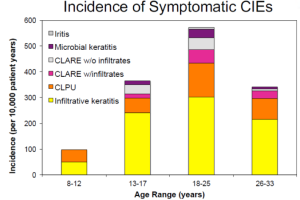By Stephanie Tsang, OD, FAAOMC
Myopia is an epidemic. We have all been hearing this paradigm shift of treating myopia as a disease, not just a refractive error. Whether it is orthokeratology, multifocal soft contacts, dual focus MiSight® 1 day*, atropine, nearwork breaks, or outdoor activity- there is much to sort through as professionals, parents, and children each decide what they want, and are able, to do.
As clinicians, after feeling like we have a decent grasp on epidemiology and evidence-based treatment options, we have one other big hurdle to get across in order to successfully implement myopia management: parents.
Traditionally, understanding the parents in our practices came via in-office, one-on-one, interactions. The zoom boom of COVID changed this as most people became comfortable with online meetings and webinars. The following is what I learned from these meetings with patients and parents over the last couple years.
- The COVID Rollercoaster
As tired as many of you may be hearing about COVID-19, the realities of its existence and effects are here to stay. From intangible emotional feelings to the very real supply chain issues, COVID-19 has touched all of our lives. In the early phases of the pandemic, many parents were confused and concerned how to best protect their children. How likely was transmission from the eyes and what to do if their kids had red eyes? Now, the conversation is more about the lingering effects of being on a screen extensively over the last two years. They want to know what they can do given the obvious changes in their kids’ vision. Simplifying the situation and objectively giving them evidence-based treatment options is usually very appreciated. Work with them to come up with a treatment plan that works for their family.
There are typically three types of parents:
1: Never heard of myopia.
2: Know about myopia but never heard it can be treated.
3: Know myopia well and interested in treatment options.
There is undoubtedly a wide range of understanding, worry (or not), and desire to act pending the parents’ own experiences. The best we can do is listen and be open about working with them; Understanding where they are coming from is a good starting point.
- Talk to the Parent AND the Child
“He never takes a break while playing Minecraft,” says mom while the kid rolls his eyes. A familiar scene in the exam chair? There is a real palpable frustration from parents sharing when their kids don’t listen to them. Empathizing with all a parent has going on and directly speaking to the child is quite effective. Kids are smart and often want to feel empowered to take care of themselves instead of being told what to do. We have a unique third party role to balance both parents’ and kid’s ideas. Kids surprise you with their thoughts and concerns when allowed to be part of the myopia management team (i.e. 20/20/20 rule). Afterall, neither we nor the parents can be by their side constantly reminding them to take care of their eyes. By directly addressing each individual, children often appreciate being involved and listened to while parents are happy to have a third party “validate” the things they say at home.
Just as there are typically three types of parents, there are three types of kids.
1: Not aware they have any issues.
2: Seeing blurry but doesn’t think it is a big deal.
3: Aware of their worsening prescription and worried.
Understanding these starting points allow us to adjust our conversation tone and patient education.
- Cost Doesn’t Really Matter
Raising kids is not cheap and money doesn't grow on trees. However, parents want to know objective findings and recommendations from you. Our job isn’t to judge whether someone can pay for treatment; It is to share what options are available. Depending on your payment structure, available treatments, and sometimes even manufacturer prescription savings cards, there are different ways we can help them attain treatment if they are interested. Even if they do not want or truly cannot afford certain treatments, if their financial situation changes or the child’s prescription worsens rapidly, they will be better equipped to look for and act on it in the future. When it comes to cost, we can think of three categories as well.
1: Truly unable to afford myopia management.
2: Can afford treatment but do not see the value.
3: Can afford treatment and is willing to pay.
Parents appreciate your honesty and empathy. They will then make a decision on what is best fit for them.
- Avoid Making Assumptions
It is easy to forget about the other parent or make assumptions about a “normal” family situation. Mom might bring the patient in but dad may have completely different concerns or ideas about myopia. Or, there may be two moms, two dads, divorced, or single parents. Sometimes scheduling an extra consultation to involve both parents is best. Other times, such as with divorced parents, it may be easier to hold separate consultations as each person needs to contribute to therapy payments but may not be communicating to each other well. This may even affect treatment success if a child is living half the week with one parent who is very committed to treatment while the other half of the week is living with a parent who doesn’t believe there’s a problem. Many little things outside of our professional knowledge must come together to make a successful myopia management case.
- Make a Connection
The most sincere and effective consultation lies in finding a connection and fulfilling a need. Everyone responds best if they trust you but the fun part also lies in shared hobbies, interests, books. Kids really open up and relax for training if you can find something to genuinely connect on. Not everything has to be about eyes. Perhaps the parent is worried about their child turning into high myopia like themselves but the child doesn’t understand that and only cares that they can play basketball without glasses. Both are valid points. It is important to celebrate the successes with what resonates best for every individual.
After speaking with patients with many different backgrounds, I find the most rewarding thing is empowering people.
Empower parents by helping them navigate their guilt, fears, worries, and all the information they acquire online or from other parents and family members.
Empower young patients by helping them understand that prevention can be easy and immediately rewarding.
There is so much to be excited for in myopia management. Finding and focusing on positive connections will go a long way in helping our patients.

Dr. Stephanie Tsang was born and raised in the California Bay Area. She graduated from Southern California College of Optometry, completed a residency at Southern Arizona Veterans Affairs Healthcare System, and is a fellow of the American Academy of Orthokeratology and Myopia Control. Dr. Tsang is fluent in English and Chinese (Cantonese and Mandarin) and is dedicated to improving the lives of her patients by providing comprehensive vision care, including the specialties of dry eye treatment and myopia control. In her free time, Dr. Tsang enjoys reading, cooking, snowboarding, and badminton.
*Indications for use: MiSight® 1 day (omafilcon A) soft (hydrophilic) contact lenses for daily wear are indicated for the correction of myopic ametropia and for slowing the progression of myopia in children with non-diseased eyes, who at the initiation of treatment are 8-12 years of age and have a refraction of -0.75 to -4.00 diopters(spherical equivalent) with ≤ 0.75 diopters of astigmatism. The lens is to be discarded after each removal.








